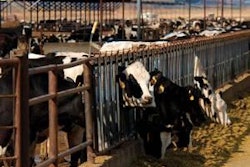A company with both "feed" and "energy" in its name might sound like a business at odds with itself, given the current environment of fuel versus feed. But in fact, Feed Energy Company, and its president, Bob Riley, are doing more than their part in building bridges between a booming biofuel industry and livestock operators in need of quality rations.
And while he may be in the feed ingredient business, Riley is very forthcoming with his opinion on the impact of biofuel production. When he bought Feed Energy Company back in the mid-1980s, he took over a company focused on combining fatty acids to meet animal nutrition needs. Today, simplicity has given way to tailor-made, his focus has broadened and he's taken his Feed Energy Company to new heights as ethanol plants and expansions continue to spring up around his Iowa headquarters.
Riley explains that in its most basic form, his company takes ingredients left over from the vegetable oil refineries and packers that are energy-related and refines and blends them into various products in demand by livestock and industrial markets. "They might need a particular make up of fatty acids for their particular needs. Certain things might work better metabolically, so we make those products for them," he explains.
Full-service formulating
A tour of Feed Energy Company's facilities reveals a surprisingly low-tech combination of apparatus. "All we have are pumps and pipes and tanks and some relatively sophisticated equipment for mixing things, but it doesn't look like an oil refinery. By the same token, our technical stuff is all done at the molecular center in our lab, analytically, and then sent out to the plant to implement," he says.
Of the various processes the company performs with fats and oils, those for the livestock market are the highest tech in nature. "For instance, if you are feeding livestock and you go to a nutritionist to find what the requirements are from an energy standpoint, then we would consider gross calorie content of the energy product in fitting the right product to that animal," Riley says. "Then we start asking other things that we can stack onto those calories. Much like various corn hybrids, we have Omega 3 and Omega 6 essential fatty acids, linoleic acids, anti-oxidant productswe have components to our products that will stabilize the whole formula, as opposed to just our product. We have other intangibles that are added in. We're a certified safe feed/safe food vendor, so we've got an extra layer of quality things that we do. We check for 72 different pesticides whereas most companies check for about 16. There's a whole host of other types of non-nutritive things we do that we stack onto our benefits list. It's what more we can provide than just a plain old pound of fat," Riley says. "It's not just fat. It's full sevice."
The current biofuel boom has affected business tremendously. But Riley says it's a trend that has taken the business back to its original knowledge of the fats and oils industry.
And it's a business that has a lot in common with the energy industry. "We determined a long time ago, for instance, that there is an interchangeability you can do with our product and natural gas or biodiesel in a boiler. As we started looking at these relationships, we started seeing pretty soon what will be driving the livestock industry: the price of oil," Riley explains.
Riley states the now obvious point that corn can be used for food or fuel and if used for fuel, food has to compete on the same level. Whatever energy needs are, is therefore going to drive the price of corn.
Valuable ingredients
The biofuel boom is making traditional feed products more scarce, that's true, but also more valuable, he continues. It is also making the feed business more intimately connected to the west Texas crude oil market. "We used to have a hog-to-corn ratio; now we have a hog-to-gasoline ratio. We have things that have jumped into the middle of an old equation and have thrown a disruptive component into it that we now don't know how to understand. Supply and demand hasn't stabilized very well. If west Texas crude goes up a dollar a barrel, we don't know what that means exactly for feed. We're still trying to come up with the relationships," he explains.
As the ethanol story began to unfold, Feed Energy Company joined with other entities in contracting with Food and Agricultural Policy Research Institute (FAPRI) to learn more about those relationships. Riley says he was also concerned about rising farm land prices and conversions from one crop to another. "How many acres are we going to lose, how many acres of pasture, what are the environmental concerns?" he asks.
Loss of export markets
While Riley sees ripple effects all through the industry, some sectors can react more quickly than others. "When we look at the ethanol train and how fast it's been going down the track, we look at how many plants are built and expanded, and how much corn we are losing, we have not had the ability to expand our acreage or yields, to use different crops or different combinations of crops. Watching the rising corn price, we have not been able to increase supply fast enough to take care of the marching giant down track. We have an imbalance that markets will bring back into some sort of order," he says. "If we look at corn being a five or 10 year stage in our energy system, this ethanol train is going to potentially move a lot of acres out of beans, production which will go to South America and won't come back even after ethanol production from corn starts to slow down." Riley says the same things might happen to animals. Producers might decide not to continue on with livestock because of price, so that might move production somewhere else.
"When we're all done with corn and ethanol, we're going to have all these acres of corn and not know what to do with them. We might see some segments that won't come back at the same strength they would have been," Riley suggests.
Land values
With the huge investment in capitol in order to afford to buy rural cropland, Riley wonders who can afford to buy land and operate it efficiently. "On top of that, about two-thirds, or 60 percent, of farmers are widows, so a lot of land is going to need to change over and go into younger ownership," he notes. "But people in that age group are not going to go down and borrow $6 million to go into farming."
Riley said another sign of the ethanol growth is prices rising across the board, from feed to fuel to food. His suppliers moved up their product price, so he's also had to increase his prices.
"I don't think a lot of people look at the total market to see how it affects everything. Everyone gets on the ethanol bandwagon, it's a great economy-maker and great for the farmer, because they're finally getting paid a decent price for their product, but it's going so fast, it looks like theoretically next year if all ethanol plants being built and added on here in Iowa come to pass, they could use the whole corn crop without feeding anything to livestock in the state."
Riley says he's also concerned about the ethanol industry's impact on future exports. He says corn exports will be shut off as land is diverted into ethanol production.
And he's not enthused over the prospect of security concerns moving from an oil dependency to a foreign food dependency. "We are trying to get independent from foreign oil but we are instead going to be dependent on foreign food or similar products. I don't think we can ever be independent if we are going to be as large of an economy and use up as many resources as we do," he suggests.
While Riley expects corn's reign for ethanol production to be limited, he doesn't think cellulostic is necessarily the best substitute. He fears too many acres of marginal land will be put back into production rather than left with the cover of cellulostic material.
Other energy sources
"My thinking is that within five to 10 years, we will have a transition that will go from corn to some corn and woody materials, which may cause some plants to locate outside the Midwest, and then probably we will just keep moving on our continuum of different energy sources. It might be some combination of various things. We might determine that wind energy we have throughout the country can provide us with energy to plug in cars at night and during the day we might be able to store energy that comes from the sun."
Added value
As a side business to his main enterprise, Riley has also been working with plants to develop practices for better consistency, in turn to help monograstic animals to use the DDGS more readily. Riley says his company, like others, is also going to be doing more work with ethanol producers to try to get more added value from the ethanol process through co-products.
Precision required
One thing he's certain of, growth in ethanol production is having an impact on how his clients feed their animals. "In our customers' situations, with the higher price for carbohydrates, they're going to be making much more energy and protein-dense diets and probably going to be more expensive, but probably will supply the animal everything it needs in a much smaller package because carbs take up lots of room in a formula," he explains. "The whole process doesn't fit very well with an industry that has tried to be a commodity-type industry. Because it's been a commodity-type industry, it's been very price-conscious. They are going to find they can't do that anymore because products they are going to be using are more high-tech, more expensive, and going to require more sophistication."
As cheap commodities go away and are used for energy sources, more expensive products will remain and have to be used very wisely because of their expense, he explains. "Being more and more precise in really measuring all these inputs is going to be a key thing. This is where high quality producers will be able to really shine in the animal industry."

















